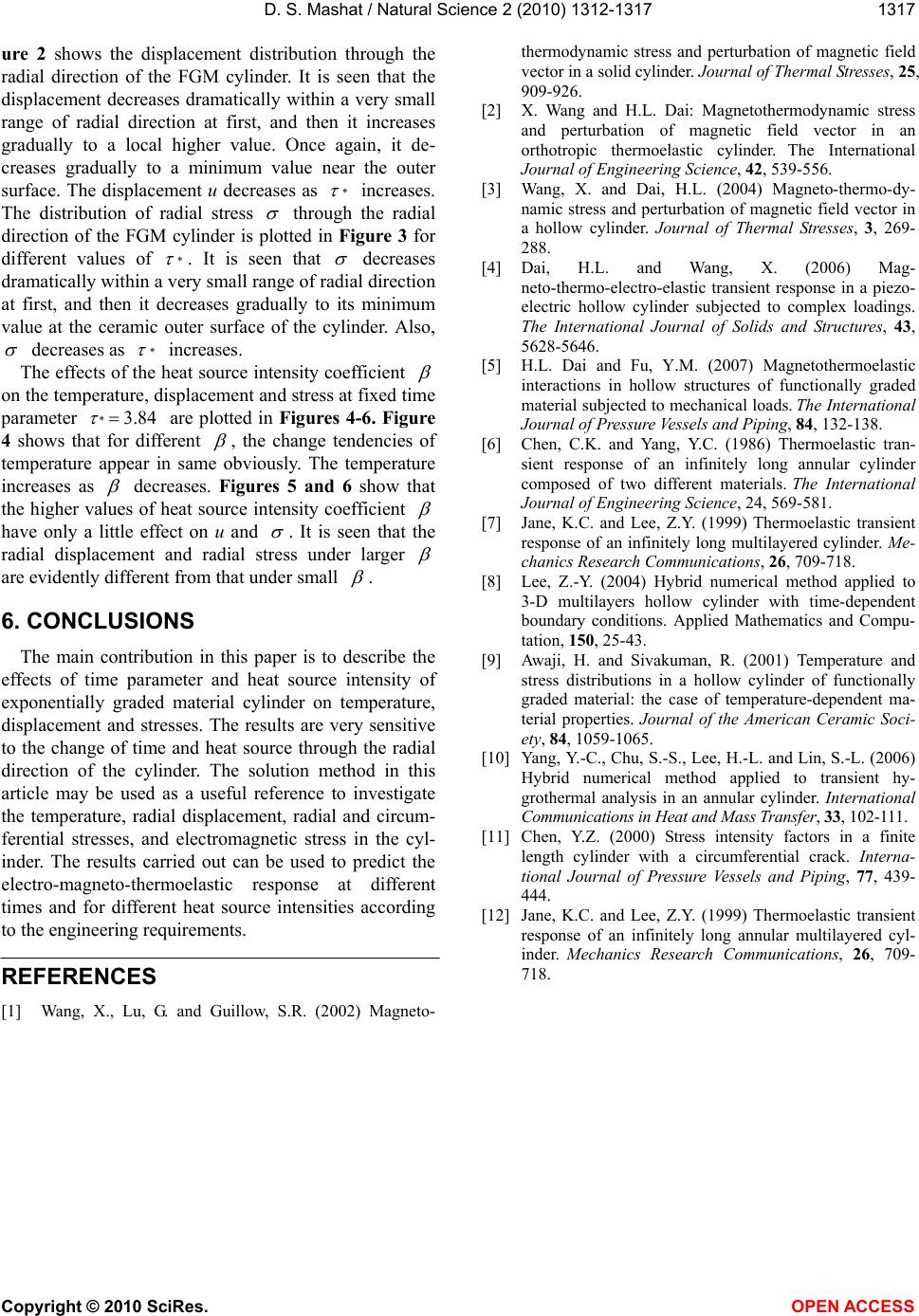
D. S. Mashat / Natural Science 2 (2010) 1312-1317
Copyright © 2010 SciRes. OPEN ACCESS
1317
ure 2 shows the displacement distribution through the
radial direction of the FGM cylinder. It is seen that the
displacement decreases dramatically within a very small
range of radial direction at first, and then it increases
gradually to a local higher value. Once again, it de-
creases gradually to a minimum value near the outer
surface. The displacement u decreases as *
increases.
The distribution of radial stress
through the radial
direction of the FGM cylinder is plotted in Figure 3 for
different values of *
. It is seen that
decreases
dramatically within a very small range of radial direction
at first, and then it decreases gradually to its minimum
value at the ceramic outer surface of the cylinder. Also,
decreases as *
increases.
The effects of the heat source intensity coefficient
on the temperature, displacement and stress at fixed time
parameter *3.84
are plotted in Figures 4-6. Figure
4 shows that for different
, the change tendencies of
temperature appear in same obviously. The temperature
increases as
decreases. Figures 5 and 6 show that
the higher values of heat source intensity coefficient
have only a little effect on u and
. It is seen that the
radial displacement and radial stress under larger
are evidently different from that under small
.
6. CONCLUSIONS
The main contribution in this paper is to describe the
effects of time parameter and heat source intensity of
exponentially graded material cylinder on temperature,
displacement and stresses. The results are very sensitive
to the change of time and heat source through the radial
direction of the cylinder. The solution method in this
article may be used as a useful reference to investigate
the temperature, radial displacement, radial and circum-
ferential stresses, and electromagnetic stress in the cyl-
inder. The results carried out can be used to predict the
electro-magneto-thermoelastic response at different
times and for different heat source intensities according
to the engineering requirements.
REFERENCES
[1] Wang, X., Lu, G. and Guillow, S.R. (2002) Magneto-
thermodynamic stress and perturbation of magnetic field
vector in a solid cylinder. Journal of Thermal Stresses, 25,
909-926.
[2] X. Wang and H.L. Dai: Magnetothermodynamic stress
and perturbation of magnetic field vector in an
orthotropic thermoelastic cylinder. The International
Journal of Engineering Science, 42, 539-556.
[3] Wang, X. and Dai, H.L. (2004) Magneto -thermo-dy-
namic stress and perturbation of magnetic field vector in
a hollow cylinder. Journal of Thermal Stresses, 3, 269-
288.
[4] Dai, H.L. and Wang, X. (2006) Mag-
neto-thermo-electro-elastic transient response in a piezo-
electric hollow cylinder subjected to complex loadings.
The International Journal of Solids and Structures, 43,
5628-5646.
[5] H.L. Dai and Fu, Y.M. (2007) Magnetothermoelastic
interactions in hollow structures of functionally graded
material subjected to mechanical loads. The International
Journal of Pressure Vessels and Piping, 84, 132-138.
[6] Chen, C.K. and Yang, Y.C. (1986) Thermoelastic tran-
sient response of an infinitely long annular cylinder
composed of two different materials. The International
Journal of Engineering Science, 24, 569-581.
[7] Jane, K.C. and Lee, Z.Y. (1999) Thermoelastic transient
response of an infinitely long multilayered cylinder. Me-
chanics Research Communications, 26, 709-718.
[8] Lee, Z.-Y. (2004) Hybrid numerical method applied to
3-D multilayers hollow cylinder with time-dependent
boundary conditions. Applied Mathematics and Compu-
tation, 150, 25-43.
[9] Awaji, H. and Sivakuman, R. (2001) Temperature and
stress distributions in a hollow cylinder of functionally
graded material: the case of temperature-dependent ma-
terial properties. Journal of the American Ceramic Soci-
ety, 84, 1059-1065.
[10] Yang, Y.-C., Chu, S.-S., Lee, H.-L. and Lin, S.-L. (2006)
Hybrid numerical method applied to transient hy-
grothermal analysis in an annular cylinder. International
Communications in Heat and Mass Transfer, 33, 102-111.
[11] Chen, Y.Z. (2000) Stress intensity factors in a finite
length cylinder with a circumferential crack. Interna-
tional Journal of Pressure Vessels and Piping, 77, 439-
444.
[12] Jane, K.C. and Lee, Z.Y. (1999) Thermoelastic transient
response of an infinitely long annular multilayered cyl-
inder. Mechanics Research Communications, 26, 709-
718.